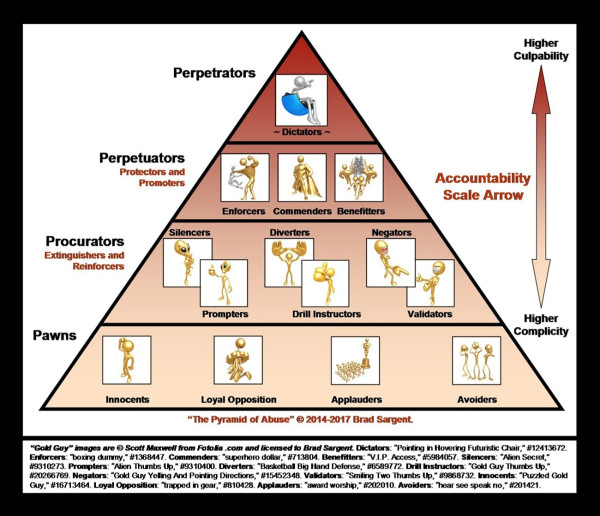
The Pyramid of Abuse and Scale of Accountability (c) 2018 Brad Sargent aka “futuristguy”
Image used by permission.
It was 2014. Mars Hill was imploding and evangelical Christians were shocked and trying to understand why and how such dysfunction could have developed in what seemed to be a thriving multicampus church that people had been encouraged to emulate.
Brad Sargent had been pondering such questions for years as a result of his own experiences. In 2014, he developed the diagram, The Pyramid of Abuse, to convey how abuse thrives in a church or Christian organization. It’s very applicable to other systems such as businesses and political parties as well. Many people have found it helpful to their understanding both of what was happening at Mars Hill and also as a useful way of understanding their own experiences in other churches or Christian organizations. It’s been repeatedly shared online.
Before reading further, look over the pyramid. What is called the “dictator” in this system is also typically called a “perpetrator.” Without getting too concerned about what each role means, what is the big idea you get from this image? What other insights spring to mind?
The Field Guides
Brad Sargent, aka Futurist Guy, has continued his work on understanding systems and abuse since the publication of The Pyramid of Abuse. He has developed free online “Field Guides” to share his knowledge with others.
It is helpful to know the organizational structure of the Field Guides ahead of time, so you’ll know what to expect on the website.
For each field guide, there is:
- A table of contents listing Sections
- A table of contents for each section listing Chapters
- A shorter table of contents for each chapter listing Topics.
Each topic has an expository section which is followed by application. The application includes questions for reflection based on stories that illustrate the concept—often, but not always drawn from the fantasy genre. Why use fiction at all? Though Futurist Guy uses some nonfiction, works of fiction that are most compelling draw our attention to clusters of character traits, motivations, and interactions that we recognize from real life—or that help us to recognize & understand these same traits, motivations, and patterns of interactions when we encounter them in our lives.
Exposition of the pyramid of abuse image
The following page on one of Brad’s blogs goes into detail about the various roles in the pyramid. Don’t let yourself get bogged down trying to definitively characterize each role as separate from others; instead, you can use the pyramid to begin the process of thinking about the roles various people play in perpetuating any system.
One helpful aspect of this article is that it explains the benefits that people in various positions receive as a consequence of the role they are playing. People can benefit from receiving “power, prestige, and prosperity.”
In addition to expository descriptions of the various roles in the diagram , Sargent uses the game of chess to further develop his readers’ understanding of how various players can work together to maintain a dysfunctional system. He explains the roles of the king, queen, the mid-level workhorses of rook/bishop/knight, and various roles that pawns can play. For example, “If organizational power systems are like chess games, the king (like Dictators) is the most powerful, in terms of privilege, though it has relatively limited options for movement. It is the piece most protected. It doesn’t venture out much, but constantly sends out other pieces to guard its position of privilege. If the king gets cornered or clobbered, it’s game over.” Having this additional grid through which to see the interlocking nature of a system was very helpful.
https://futuristguysfieldguides.wordpress.com/1-1-field-guide-1/section-03/chapter-08/
You can read more at https://futuristguysfieldguides.wordpress.com/1-1-field-guide-1/section-03/chapter-06/ This article covers how the image of the abusive pyramid came to be, more on roles in the pyramid, and how abusive systems get going in the first place.
Personal reflection:
If you are, or were, part of an organization where it seems that something is amiss, or you are part of an organization where mistreatment or abuse has been alleged, you may want to use this pyramid as a jumping off point to think through the roles various individuals have played or are playing.
What role or roles have you played in the past or are you playing in the present? Are you passively or actively supporting the system? Are you resisting the system? What has motivated you to play the roles you’ve taken on?